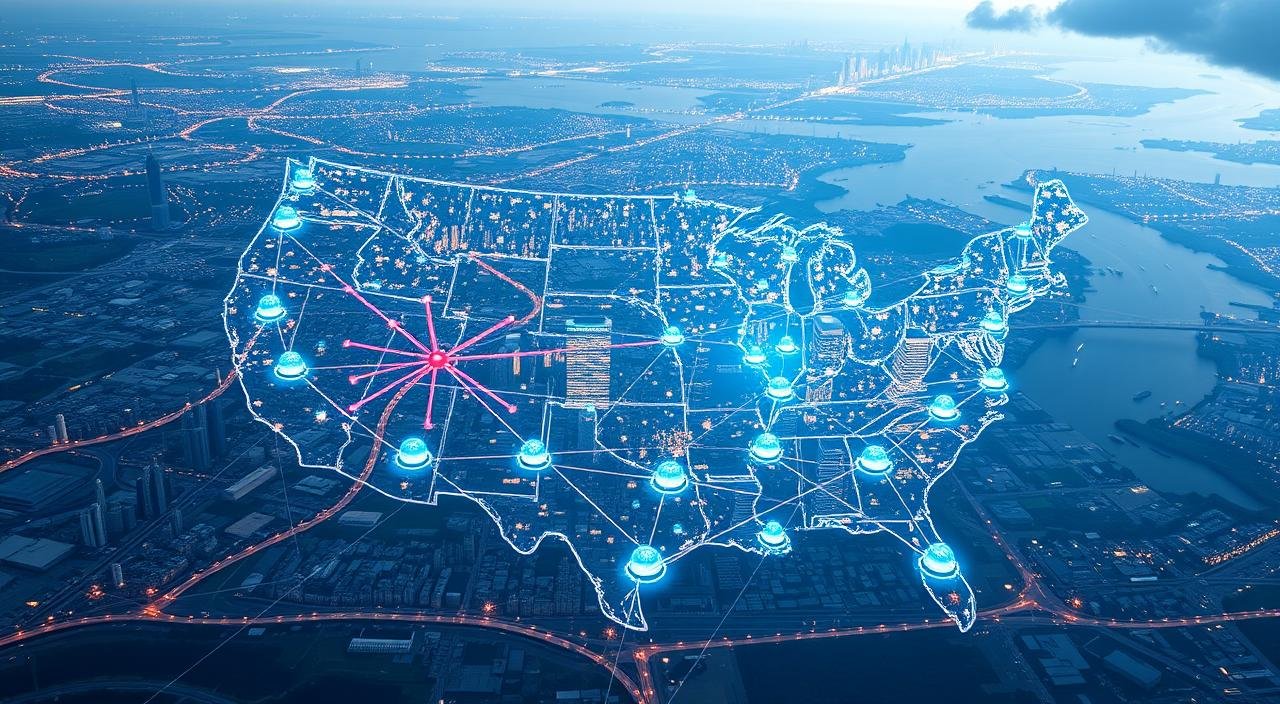Internet of Things: The Future of Smart Home Technology and Connectivity
Ever ponder how connected technology is reshaping your daily life, simplifying tasks and boosting efficiency? The Internet of Things (IoT) applications are more than just tech jargon; they’re revolutionizing our daily routines. From waking up to a smart alarm that syncs with your sleep patterns to your fridge reminding you to buy groceries, smart devices are becoming integral to our lives. As we explore further, you’ll see how these innovations not only make life more convenient but also elevate our overall quality of life.
Key Takeaways
- The Internet of Things (IoT) connects devices to enhance home and work life.
- Smart devices enable personalized experiences, from health monitoring to energy efficiency.
- Understanding IoT applications helps you utilize technology to its full extent.
- Connected technology is vital in sectors like healthcare, agriculture, and transportation.
- Embracing IoT solutions can lead to safer and smarter urban environments.
Understanding the Internet of Things (IoT)
The Internet of Things (IoT) marks a major advancement in technology. It connects a vast network of devices that collect, share, and analyze data effortlessly. This field includes sensors, IoT technology, and connectivity, all working together to create intelligent environments. Picture a world where everyday items can talk to each other, improving our lives and making things more efficient.
At the core of IoT is the ability to gather real-time data through sensors. These devices send information over networks, enabling instant analysis and action. This connectivity creates an ecosystem that automates tasks in healthcare, manufacturing, and urban planning. As more businesses adopt IoT, its widespread use becomes more likely, showing its groundbreaking impact.
Think about how IoT could change your daily life. Imagine smart home devices adjusting settings based on your preferences or industrial machines predicting when they need maintenance. The possibilities are endless. IoT’s ability to connect and meet user needs is transforming homes and businesses, changing how we interact with our environment.
| Component | Description | Example |
|---|---|---|
| Sensors | Devices that detect and collect data about their environment. | Temperature sensors in smart thermostats |
| Connectivity | The ability for devices to communicate over the internet. | Wi-Fi, Bluetooth, cellular networks |
| Data Analytics | Processes that interpret collected data to derive insights. | Predictive analytics for equipment maintenance |
| Actuators | Devices that perform actions based on processed data. | Smart locks that engage automatically |
How IoT Applications Enhance Daily Living
IoT applications revolutionize daily life by boosting connectivity and efficiency in numerous areas. Smart homes, for instance, use IoT to automate mundane tasks. Sensors adjust lighting and temperature according to your preferences and schedule, making life easier and more comfortable.
In healthcare, IoT brings significant advancements. Wearable devices track vital signs, keeping you updated on your health status. These devices not only provide real-time health data but also notify healthcare professionals when needed, promoting active health management.
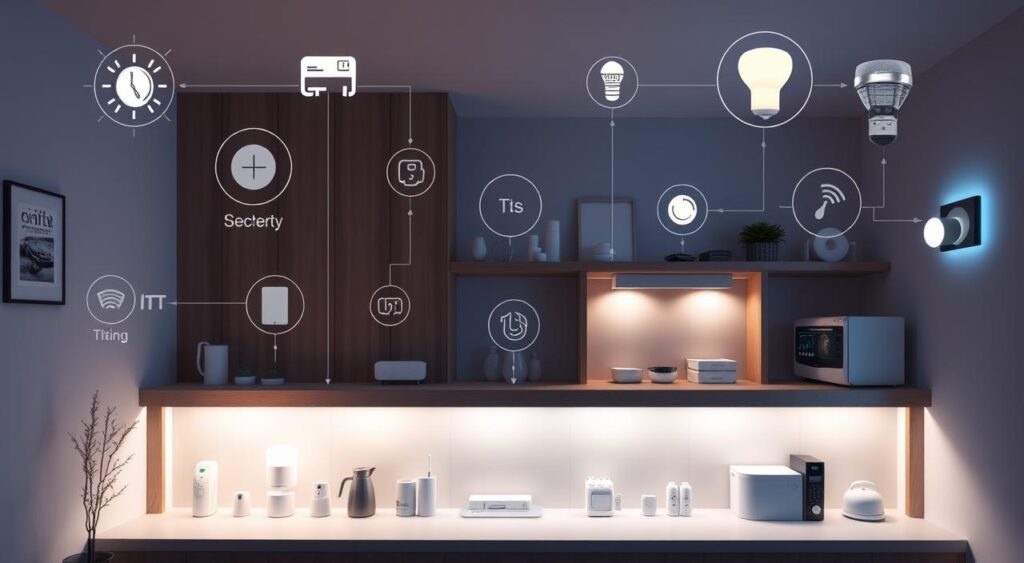
Transportation also sees innovation with IoT. IoT traffic management systems reduce congestion and improve commutes. They analyze traffic patterns in real-time, enabling efficient route planning. Connected vehicles, on the other hand, enhance safety and optimize fuel usage through data analysis.
In conclusion, IoT applications show their value in improving efficiency and connectivity across various life domains. By integrating advanced technology into our daily routines, IoT solutions enhance our quality of life. They simplify and streamline our daily activities, making them more effective.
Smart Home Devices: Your Personal Assistant
Smart home devices act as your personal assistant, making daily tasks easier and boosting security and comfort. They enable home automation, fitting seamlessly into your life. The rise of new technologies is making our living spaces more efficient.
Home Automation Trends
Home automation trends are seeing a surge in voice-activated smart devices like speakers, thermostats, and kitchen appliances. The Matter protocol aims to improve how devices from different brands talk to each other. Big names like Google, Amazon, Samsung, and Apple are backing this standard. This makes setting up devices easier and improves how we use them.
- Integration of touchless technology and voice activation in kitchen gadgets
- Projected growth in the smart kitchen sink market, focusing on saving energy
- Real-time LED displays for water temperature in smart sinks
Energy Efficiency with Smart Solutions
Smart home devices help save energy, cutting down on utility bills and helping the environment. For example, smart kitchen sinks with sensors can save up to 30% more water than regular sinks. Devices like Apple’s latest iPhones use Bluetooth Low Energy for easy setup and management through smartphones.
More than 60% of people want to buy smart devices for their homes. This shows a growing interest in technologies that make life easier and more energy-efficient.
Connected Technology in Healthcare
The integration of connected technology in healthcare has transformed medical care delivery. As healthcare evolves, new tools emerge to improve patient monitoring and management. Wearable devices are key, allowing individuals to track their health in real-time. This access to vital data enables healthcare providers to offer proactive care.
Wearable Devices for Health Monitoring
Wearable devices, like fitness trackers and smartwatches, are vital for personal health management. They collect health metrics continuously, including heart rate, activity levels, and sleep patterns. With connected technology, users can share this data with healthcare professionals. This facilitates tailored health interventions and support, empowering individuals and ensuring timely medical advice.
Remote Patient Management Systems
Remote patient management systems are changing how we access healthcare. They use connected technology for virtual consultations, allowing patients to receive care at home. This model improves accessibility and streamlines patient care management. Healthcare providers can monitor patients remotely, adjust treatments, and reduce in-person visits. Patients benefit from better outcomes and a more personalized health approach.
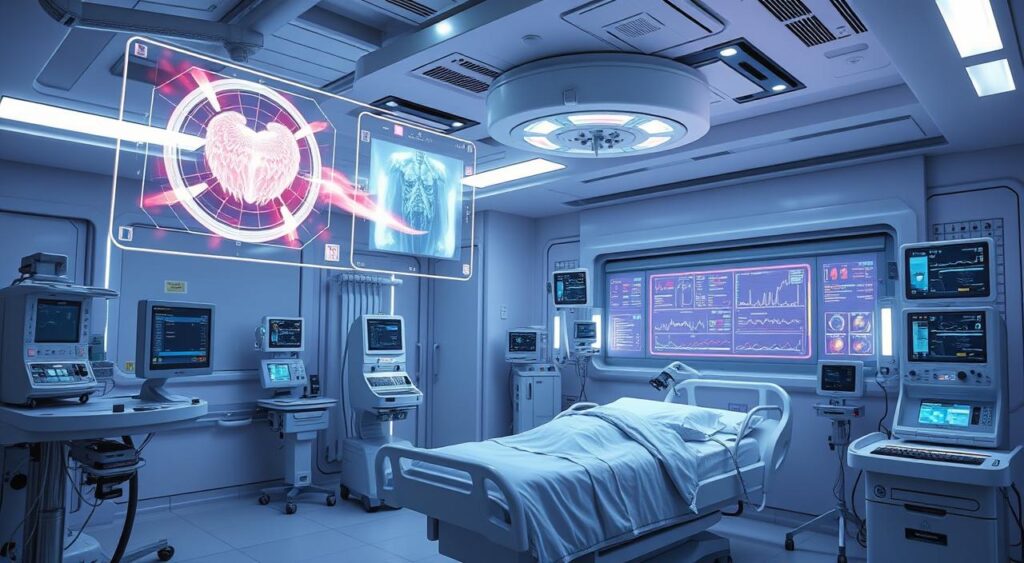
| Feature | Wearable Devices | Remote Patient Management |
|---|---|---|
| Purpose | Continuous health tracking | Real-time patient monitoring and consultations |
| Data Collected | Heart rate, steps, sleep data | Vital signs, health history, treatment progress |
| Patient Engagement | Empowers self-monitoring | Increases accessibility to healthcare |
| Healthcare Integration | Links to health records | Facilitates virtual care |
| Outcome Improvement | Better personal health awareness | Enhances timely medical interventions |
Internet of Things (IoT) Applications in Transportation
IoT applications in transportation are transforming travel and logistics management. They use technology to boost efficiency, leading to smarter decisions and safer roads.
Smart Traffic Management Systems
Smart traffic management uses real-time data analytics to optimize urban traffic flow. Sensors and cameras monitor traffic, reducing congestion and improving safety. These systems adjust signal timings based on traffic patterns, making commutes better. The result is:
- Reduced travel times
- Decreased fuel consumption
- Lower emissions
- Enhanced public transportation efficiency
Connected Vehicles and Fleet Management
Connected vehicles offer numerous benefits for fleet management. They allow tracking vehicle locations, monitoring driving habits, and scheduling maintenance. Key benefits include:
- Improved routing through GPS and traffic updates
- Enhanced safety features through collision detection
- Efficient fuel management leading to cost savings

The combination of smart traffic management and connected vehicles enables cities and businesses to create a more efficient, sustainable transportation system.
| Feature | Smart Traffic Management | Connected Vehicles |
|---|---|---|
| Data Usage | Real-time traffic analytics | Driver behavior monitoring |
| Impact on Congestion | Reduces traffic bottlenecks | Improves routing |
| Environmental Benefits | Lower greenhouse gas emissions | Reduced fuel consumption |
| Cost Efficiency | Minimal operational costs | Lower maintenance expenses |
IoT Solutions in Agriculture
The integration of IoT solutions in agriculture is revolutionizing traditional farming practices. Precision farming techniques allow farmers to boost productivity and cut down on resource waste. This section delves into how advanced technology aids in sustainable crop management and boosts agricultural efficiency.
Precision Farming Techniques
Precision farming uses IoT technology to offer farmers valuable insights. It leverages data from various sensors to guide more informed decisions. Key precision farming applications include:
- Soil Moisture Sensors: These devices monitor hydration levels in real-time, enabling farmers to optimize irrigation. This can cut water usage by up to 30%.
- GPS-Guided Tractors: Over 70% of large farms in Nebraska use these systems to boost efficiency in planting and harvesting.
- Drones and Aerial Imaging: Farmers employ drones for crop scouting and field mapping. This improves visibility into crop health and area coverage.
Improving Crop Management with IoT Sensors
IoT sensors are critical in advancing crop management practices. By installing various sensors and monitoring devices, farmers can track vital indicators like soil health, weather conditions, and crop growth stages. The advantages include:
- Enhanced Monitoring: Nearly 70% of farmers using IoT devices report better crop management compared to traditional methods.
- Pest Management Optimization: Predictive analytics from IoT data can improve pest control, potentially reducing pesticide use by around 15%.
- Efficient Resource Allocation: With accurate data, farmers can better allocate resources, leading to up to 20% increase in crop yield.
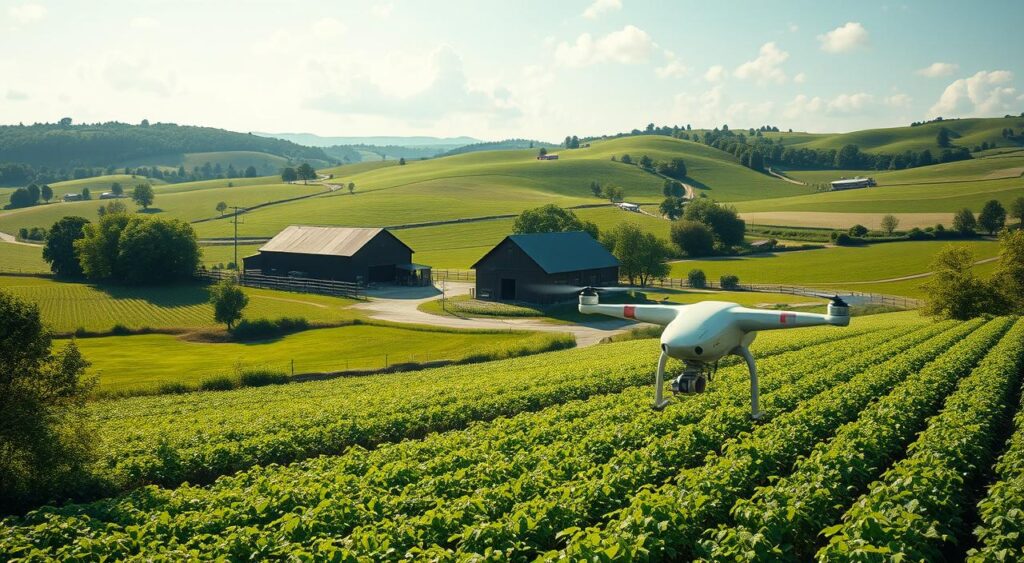
Smart Cities and Urban Development
Smart cities are revolutionizing urban development, using cutting-edge tech to improve life quality. IoT solutions are key in making cities smarter and more efficient. By introducing new systems and connected tech, cities can deliver better services and manage resources more effectively.
IoT in Public Safety and Security
The rise of IoT in public safety has brought about advanced surveillance and emergency response systems. Cities can now watch over public areas better, acting quickly in emergencies. These advancements enable:
- Real-time data collection for crime trend analysis
- Improved communication between law enforcement and emergency services
- Enhanced public awareness through timely alerts and notifications
Waste Management Innovations
Smart cities are also seeing big strides in waste management thanks to IoT. Sensors in waste bins alert services when they’re full, streamlining collection. This results in:
- Reduced operational costs by minimizing unnecessary collection trips
- Better route planning for waste collection trucks
- Lower greenhouse gas emissions through efficient logistics
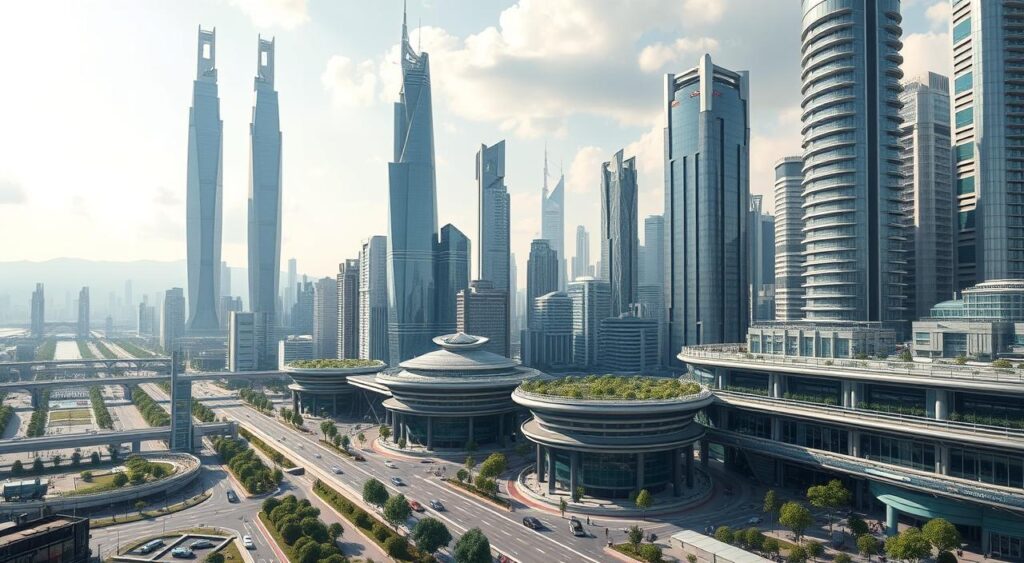
How IoT Platforms Facilitate Connected Devices
IoT platforms serve as critical frameworks for device connectivity and data management. They integrate multiple devices, fostering seamless communication and real-time information exchange. This integration is vital in sectors like agriculture, healthcare, and smart cities.
Effective IoT platforms offer scalability, security, and interoperability. Scalability ensures network growth without performance loss. Security safeguards sensitive data. Interoperability allows diverse devices to communicate, creating a unified IoT ecosystem.
For example, MAVOCO’s Connectivity Management Platform (CMP) enhances precision farming. It integrates advanced technologies like soil moisture sensors and GPS-guided tractors. These tools efficiently manage resources, boosting crop yields.
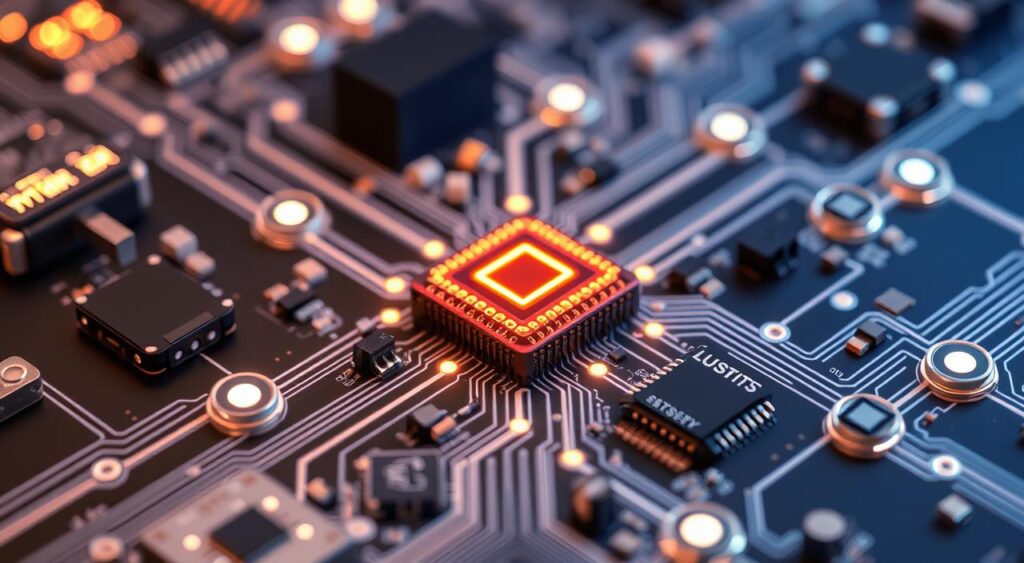
IoT platforms enable farmers to monitor data in real-time, improving operational efficiency. In healthcare, they facilitate remote patient management, leading to better health outcomes.
The table below showcases the importance of IoT platform features:
| Feature | Impact on Device Connectivity |
|---|---|
| Scalability | Facilitates network expansion and future growth |
| Security | Protects sensitive data from breaches |
| Interoperability | Ensures devices from different manufacturers work together |
| Real-time Data Processing | Enables immediate response to changing situations |
| Advanced Analytics | Transforms raw data into actionable insights |
In conclusion, IoT platforms are essential for device connectivity and data management across industries. They integrate systems and support business analytics, making them vital in the development of smart technologies.
IoT Implementation in Business Operations
IoT implementation is key in transforming business operations across various sectors. It integrates advanced technologies to streamline processes, enhance supply chain capabilities, and improve customer experience. This section explores how IoT solutions boost supply chain management and customer relations.
Streamlining Supply Chain Processes
IoT solutions significantly optimize supply chain processes. Real-time tracking technologies provide immediate visibility into inventory and shipment status. This allows for better decision-making and efficiency.
Predictive analytics help organizations anticipate demand, reducing waste and ensuring adequate stock levels. This proactive approach leads to cost reductions and more effective resource management.
Improving Customer Experience with IoT Solutions
IoT technology enhances customer experience in several impactful ways. Personalized services adapt to user preferences, tailoring offers and recommendations based on consumer behavior. Targeted marketing campaigns, powered by real-time data and analytics, foster deeper customer engagement and loyalty.
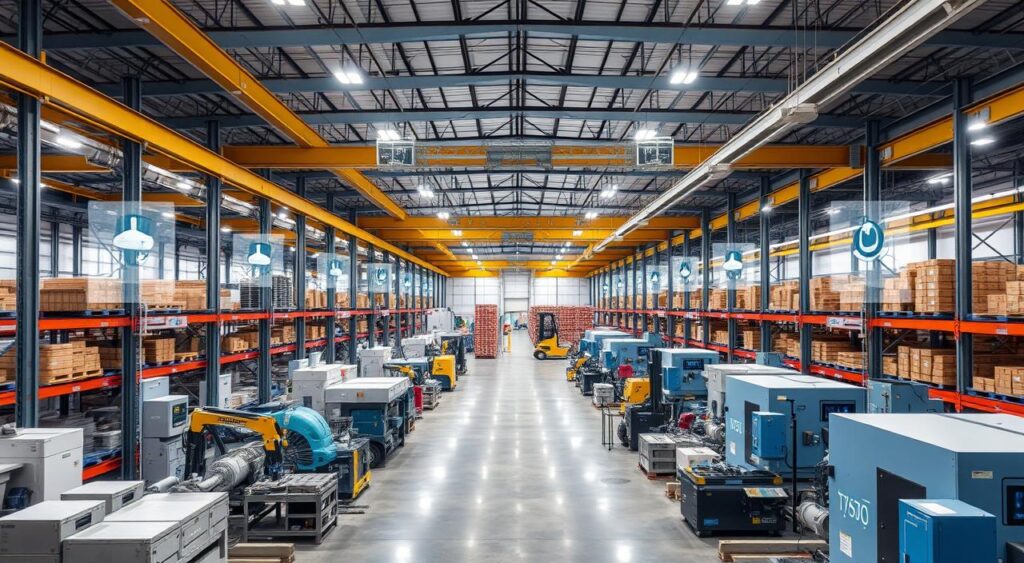
| Aspect | Traditional Approach | IoT Implementation |
|---|---|---|
| Supply Chain Visibility | Limited tracking; delays in updates | Real-time tracking; immediate updates |
| Inventory Management | Manual processes; higher error rates | Automated systems; reduced errors |
| Data Usage | Static reports; historical data | Dynamic analytics; real-time insights |
| Customer Engagement | Generic marketing strategies | Personalized interactions; targeted offers |
| Operational Costs | Higher expenses due to inefficiencies | Cost savings through optimized operations |
The Impact of IoT Sensors on Daily Activities
IoT sensors are transforming our daily lives by providing data-driven insights and facilitating automation. They track various parameters, enabling more informed decisions in homes and workplaces. This technology is changing how we interact with our environments.
In homes, IoT sensors monitor energy usage, optimizing consumption through automation. For example, smart thermostats adjust heating or cooling based on your habits, improving comfort and energy efficiency. Smart lighting systems also adapt to natural light levels, reducing the need for artificial lighting.

In industrial settings, IoT sensors enhance operational efficiency by analyzing real-time data. This allows businesses to automate tasks, streamline workflows, and reduce downtime. For instance, manufacturing facilities use IoT sensors to predict maintenance needs, ensuring smoother operations.
IoT sensors also have the power to transform agriculture. By monitoring soil moisture and crop health, farmers can automate irrigation systems. This leads to better resource management, improved crop yields, and supports sustainable farming practices.
- Tracking environmental conditions such as temperature and humidity.
- Monitoring energy usage to enhance efficiency.
- Automating mundane tasks to improve quality of life.
As IoT sensors become more prevalent in our daily devices, their impact will continue to grow. This technology is driving advancements in automation, improving personal convenience and productivity across various sectors.
The Future of IoT: Opportunities and Challenges
The future of IoT is rapidly evolving, bringing both promising opportunities and significant challenges. As technology advances, the focus on IoT connectivity intensifies. The introduction of 5G technology is set to enhance communication speed and reliability among connected devices.
Advancements in IoT Connectivity
Enhanced connectivity unlocks a plethora of applications, facilitating seamless integration across various industries. Companies are pouring substantial investments into IoT technology. Qualcomm, for instance, aims to tap into a $900 billion market by 2030, targeting integration in over 50 billion devices. This ambition not only highlights growth prospects but also underlines the increasing dependence on IoT systems.
Yet, several challenges threaten the expansion of IoT. Security remains a critical concern, as the rise in connected devices escalates cyber threat vulnerabilities. Regulatory obstacles also complicate the deployment of IoT solutions. The need for standardization across IoT protocols is pressing, ensuring device compatibility and interoperability. Initiatives like the Matter protocol, backed by leading tech companies, aim to tackle these issues.
Investments in artificial intelligence are reshaping the IoT landscape. Companies like Microsoft and Meta are committing billions to AI research, fostering a synergy between AI and IoT. This collaboration could unlock new functionalities for connected devices. It suggests that, despite hurdles, the vast opportunities in the future of IoT can lead to integrated, efficient, and seamless technological systems.
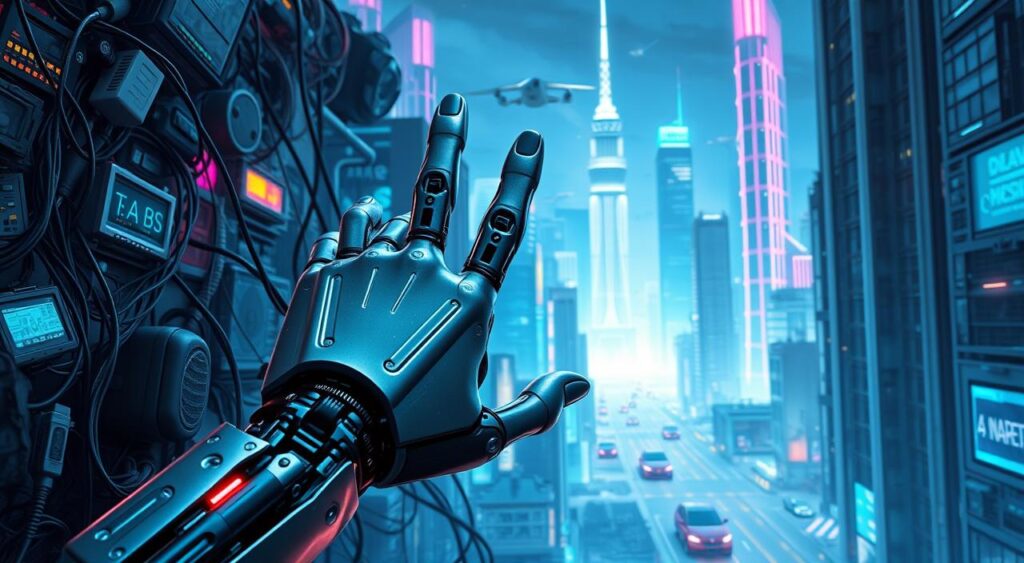
Exploring IoT Innovations Transforming Industries
The Internet of Things (IoT) is revolutionizing various sectors, boosting efficiency, innovation, and user experiences. Through real-world examples, you’ll see how IoT is reshaping industries. These case studies highlight successful integrations and the advantages of adopting IoT technologies.
Case Studies of Successful IoT Integrations
Many companies have adopted IoT solutions, achieving significant results. Here are some notable examples:
- Smart Manufacturing: A leading manufacturer used IoT sensors to monitor equipment health. This led to a 20% reduction in downtime and substantial cost savings.
- Connected Retail: Retailers have implemented IoT to track inventory in real time. This has improved stock accuracy by 30%, leading to better customer experiences.
- Energy Management: A major utility provider introduced smart meters with IoT technology. This resulted in a 15% decrease in energy consumption among users in demand-response programs.
These examples show the significant impact of IoT innovations on industries. They highlight the importance of IoT in driving technological progress. The documented benefits offer a guide for organizations considering IoT integration.
| Industry | IoT Innovation | Impact |
|---|---|---|
| Manufacturing | Predictive Maintenance | 20% reduction in downtime |
| Retail | Real-Time Inventory Tracking | 30% improvement in stock accuracy |
| Utilities | Smart Meter Deployment | 15% decrease in energy consumption |
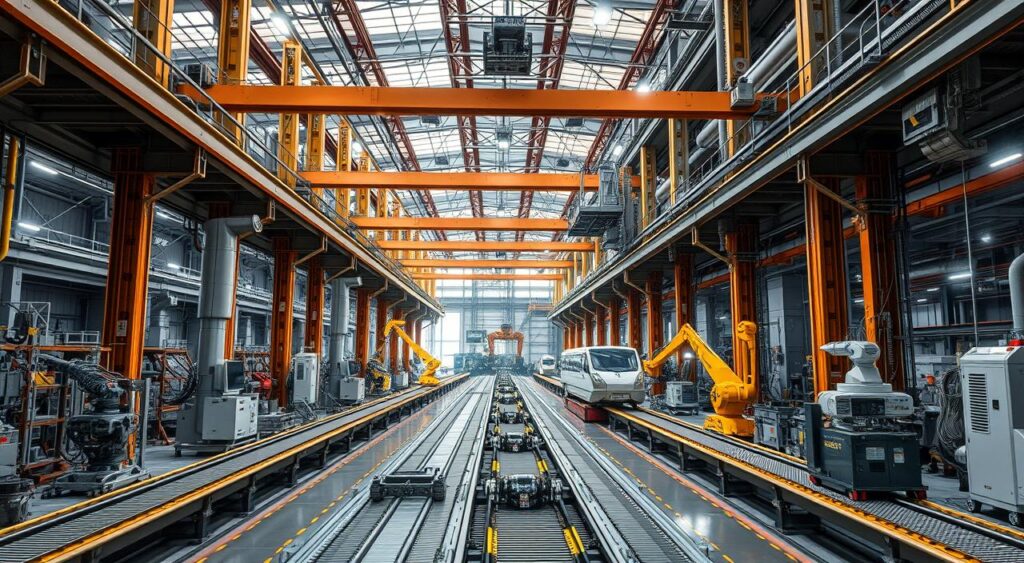
Conclusion: Internet of Things (IoT) applications
The Internet of Things (IoT) has revolutionized how we interact with our surroundings, boosting connectivity, efficiency, and daily experiences. It has transformed various sectors, from smart homes to advanced healthcare, making tasks easier and life better. As you embrace these innovations, the role of IoT in your daily life becomes clear.
The future of IoT looks bright, promising smarter cities, better transportation, and tailored healthcare. Yet, we must tackle the challenges these advancements bring. By creating a sustainable and innovative IoT ecosystem, we can unlock more benefits. These will not only improve your daily life but also ensure technology is used responsibly for future generations.
Looking ahead, the Internet of Things will continue to evolve. It’s up to you to embrace these changes. By staying informed and adaptable, you can fully enjoy the transformative impact these advancements will have on our world.



